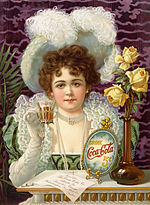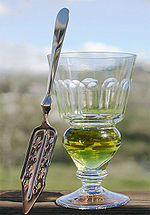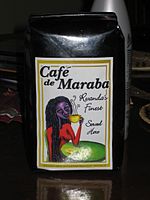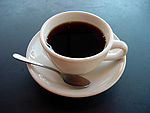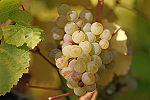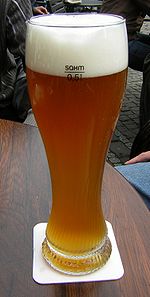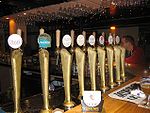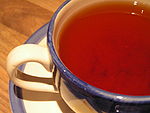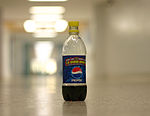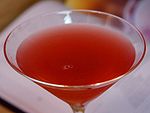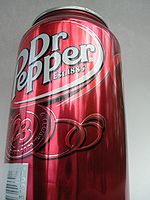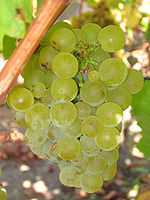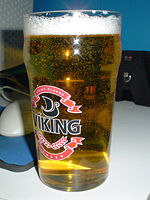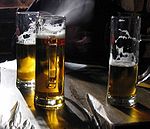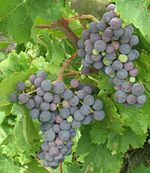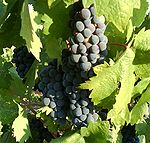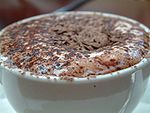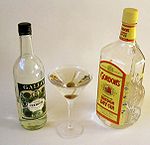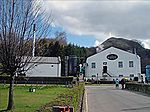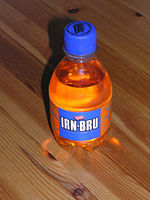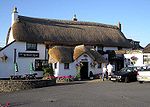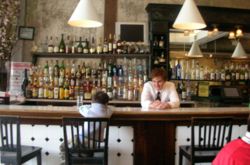- Portal:Drink/Selected article
-
These are the articles that are featured on the Drink Portal main page.
If you wish to add an article, you will be expected to make a good-faith effort to address objections that are raised. Consensus must be reached for an article to be promoted to be given selected article status. When adding a qualifying article, it must be classified as a Good article or better. These articles can be found in the Category:A-Class Food and drink articles, Category:FA-Class Food and drink articles and Category:GA-Class Food and drink articles categories. Please note that you cannot determine the status of an article that you have worked on.
Please follow the usage instructions listed below when placing a new article here,
Selected content:
- Selected article ←
- Selected pictures
- Selected people
- Selected recipes
- Selected quotes
- Selected ingredients
Selected content tools:
- What is a featured article?
- What is a featured list?
- What is a featured picture?
- What is a featured topic?
- What is a good article?
Usage
The template for used to configure these sub-pages is located at {{Selected article}}
- Add a new Selected article to the next available sub-page.
- Update "max=" to new total for its {{Random portal component}} on the main page.
- Please rotate articles to maintain a balance of the various beverage projects:
- Soft Drinks
- Spirits (Distilled beverages)
- Mixed Drinks
- Beer
- Wine
- Coffee & Tea
Selected article 1
Portal:Drink/Selected article/1Coca-Cola is a carbonated soft drink sold in stores, restaurants and vending machines worldwide (The Coca-Cola Company claims that it is sold in over 200 countries [1]). It is produced by The Coca-Cola Company in Atlanta, Georgia and is often referred to simply as Coke or (in European and American countries) as Cola or Pop. Originally intended as a patent medicine when it was invented in the late 19th century by John Pemberton, Coca-Cola was bought out by businessman Asa Griggs Candler, whose marketing tactics led Coke to its dominance of the world soft drink market throughout the 20th century. The company produces concentrate, which is then sold to various licensed Coca-Cola bottlers throughout the world. The bottlers, who hold territorially exclusive contracts with the company, produce finished product in cans and bottles from the concentrate in combination with filtered water and sweeteners. The bottlers then sell, distribute and merchandise Coca-Cola in cans and bottles to retail stores and vending machines. Such bottlers include Coca-Cola Enterprises, which is the largest single Coca-Cola bottler in North America and western Europe. The Coca-Cola Company also sells concentrate for fountain sales to major restaurants and food service distributors.
The Coca-Cola Company has, on occasion, introduced other cola drinks under the Coke brand name. The most common of these is Diet Coke, which has become a major diet cola. However, others exist, including Caffeine-Free Coca-Cola, Diet Coke Caffeine-Free, Cherry Coke, Coca-Cola Zero, Vanilla Coke and special editions with lemon and with lime and even with coffee.
Selected article 2
Portal:Drink/Selected article/2Absinthe is a distilled, highly alcoholic, anise-flavored spirit derived from herbs including the flowers and leaves of the medicinal plant Artemisia absinthium, also called wormwood. Although it is sometimes incorrectly called a liqueur, absinthe does not contain added sugar and is therefore classified as a liquor. Absinthe originated in Switzerland as an elixir, but is more well-known for its popularity in late 19th and early 20th century France, particularly among Parisian artists and writers whose romantic associations with the drink still linger in popular culture. In its heyday the most popular brand of absinthe worldwide was Pernod Fils. At the height of this popularity, absinthe was portrayed as a dangerously addictive, psychoactive drug; the chemical thujone was blamed for most of its deleterious effects. By 1915 it was banned in a number of European countries and the United States. Modern evidence shows it to be no more dangerous or psychoactive than ordinary alcohol. A modern-day absinthe revival began in the 1990s, as countries in the European Union began to reauthorize its manufacture and sale. Selected article 3
Portal:Drink/Selected article/3Maraba Coffee (Kinyarwanda: Ikawa ya Maraba; French: Café de Maraba) is a Fairtrade-certified coffee grown in the Maraba area of southern Rwanda. Maraba's coffee plants are the Bourbon variety of the Coffea arabica species and are grown on fertile volcanic soils on high-altitude hills. The fruit is handpicked, mostly during the rainy season between March and May, and brought to a washing station in Maraba, where the coffee beans are extracted and dried. At several stages, the beans are sorted according to quality. The farmers receive credits based on the amount and quality of the beans they provide.
The beans are sold to various roasting companies, with the best beans going to Union Coffee Roasters of the United Kingdom and Community Coffee of the United States. Rwanda Specialty Coffee Roasters buys from Maraba and sells to the domestic market. Maraba Coffee is also brewed into a beer.
About 2,000 smallholder farmers grow the coffee plants under the Abahuzamugambi cooperative, founded in 1999. Since 2000, the cooperative has been supported by the National University of Rwanda (NUR) and the PEARL. The cooperative has improved coffee quality and penetrated the specialty market.
Selected article 4
Portal:Drink/Selected article/4Coffee is a widely-consumed stimulant beverage prepared from roasted seeds, commonly called coffee beans, of the coffee plant. Coffee was first consumed in the 9th century, when it was discovered in the highlands of Ethiopia. From there, it spread to Egypt and Yemen, and by the 15th century had reached Armenia, Persia, Turkey, and North Africa. From the Muslim world, coffee spread to Italy, and then to the rest of Europe and later the Americas. Today, coffee is one of the most popular beverages worldwide. To produce coffee, coffee berries, which contain coffee beans, are picked, processed, and dried. The seeds are then roasted, undergoing several physical and chemical changes. They are then ground and brewed to create coffee. Coffee is an important export commodity. In 2004, coffee was the top agricultural export for 12 countries, and in 2005, it was the world's seventh largest legal agricultural export by value. Selected article 5
Portal:Drink/Selected article/5Riesling is a white grape variety which originates in the Rhine region of Germany. Riesling is an aromatic grape variety displaying flowery, almost perfumed, aromas as well as high acidity. It is used to make dry, semi-sweet, sweet and sparkling white wines. Riesling wines are usually varietally pure and are seldom oaked. As of 2004, Riesling was estimated to be the world's 20th most grown variety at 48,700 hectares (120,000 acres) (with an increasing trend), but in terms of importance for quality wines, it is usually included in the "top three" white wine varieties together with Chardonnay and Sauvignon Blanc. Riesling is a variety which is highly "terroir-expressive", meaning that the character of Riesling wines is clearly influenced by the wine's place of origin. In 2006, Riesling was the most grown variety in Germany, and in the French region of Alsace. There are also significant plantings of Riesling in Austria, northern Italy, Australia, New Zealand, United States, Canada, China and Ukraine. In the countries where it is cultivated, Riesling is most commonly grown in colder regions and locations. Selected article 6
Portal:Drink/Selected article/6A wheat beer glass is a glass that is used to serve wheat beer, known also as Weizenbier or Weißbier. The German glass generally holds 0.5 litres with room for foam or "head". It is much taller than a pint glass, and is considerably wider at the top than at the base, with a slight hourglass taper toward the bottom. This design purportedly allows greater production of foam, as well as increased exposure to air when the glass is tilted back. In other countries such as Belgium, the glass may be 0.25 litres or 0.33 litres. Because of its unique shape, extra care must be taken when pouring a beer into a wheat beer glass to produce the desired head volume. The traditional method of pouring Weißbier is to first rinse the glass with cold water, then, without drying the glass, hold the bottle and glass almost horizontally while slowly pouring the beer. When the level of the beer touches the lip of the bottle, slowly bring the glass upright. When there is less than one inch (or a few centimeters) of beer left in the bottle, swirl the bottle vigorously to pick up the sediment and create foam, which is poured on top.[2] If done correctly, the foam should just crest the lip of the glass without pouring over.
Selected article 7
Portal:Drink/Selected article/7Draught beer (also known as draft beer or tap beer) has several related though slightly different understandings. The majority of references to draught beer are of filtered beer that has been served from a pressurized container, such as a keg or a widget can. A narrower meaning is beer that is served from a keg (or tap), but not from a can, bottle or cask, is also used. A more traditional definition is beer that is served from a large container, which could be either a keg or a cask. The different understandings may at times overlap and cause confusion. Some traditionalists object to the more modern use of the word when applied to canned beer. The slight usage differences of the term is due to the history and development of beer dispensing. Selected article 8
Portal:Drink/Selected article/8Ripening Tempranillo grapesTempranillo is a variety of black grape widely grown to make full-bodied red wines[3] in its native Spain. It is the main grape used in Rioja, and is often referred to as Spain's "noble grape".[4] Its name is the diminutive of the Spanish temprano ("early"),[3] a reference to the fact that it ripens several weeks earlier than most Spanish red grapes.Tempranillo wines can be consumed young, but the most expensive ones are aged for several years in oak barrels. The wines are ruby red in colour, with aromas and flavors of berries, plum, tobacco, vanilla, leather and herb.
Selected article 9
Portal:Drink/Selected article/9Tea refers to the agricultural product of the leaves, leaf buds, and internodes of Camellia sinensis, prepared and cured by various methods. "Tea" also refers to the aromatic beverage prepared from such cured leaves by combination with hot or boiling water[5] and the colloquial name for the Camellia sinensis plant itself. Tea is the most widely-consumed beverage after water.[6] It has a cooling, slightly bitter, astringent flavour.[7]
The four types of tea most commonly found on the market are black tea, oolong tea, green tea and white tea.[8] Pu-erh tea is also often classified as among the most popular types of tea.[9]
The term "herbal tea" usually refers to an infusion or tisane of fruit or herbs that contains no Camellia sinensis.[10] The term "red tea" refers to an infusion made from the rooibos plant, also containing no Camellia sinensis.
Selected article 10
Portal:Drink/Selected article/10Pepsi-Cola is a carbonated beverage that is produced and manufactured by PepsiCo. It is sold in stores, restaurants and from vending machines. The drink was first made in the 1890s by pharmacist Erich Drafahl in New Bern, North Carolina. The brand was trademarked on June 16, 1903. There have been many Pepsi variants produced over the years since 1903, including Diet Pepsi, Crystal Pepsi, Pepsi Twist, Pepsi Max, Pepsi Samba, Pepsi Blue, Pepsi Gold, Pepsi Holiday Spice, Pepsi Jazz, Pepsi X (available in Finland and Brazil), Pepsi Next (available in Japan and South Korea), Pepsi Raw, Pepsi Retro in Mexico, Pepsi One, Pepsi Ice Cucumber and Pepsi White in Japan. In October 2008, Pepsi announced they would be redesigning their logo and re-branding many of their products by early 2009. In 2009, Pepsi, Diet Pepsi and Pepsi Max began using all lower-case fonts for name brands, Mountain Dew has been renamed "Mtn Dew", and Diet Pepsi Max was be re-branded as Pepsi Max. The brand's blue and red globe trademark became a series of "smiles," with the central white band arcing at different angles depending on the product. The new imagery is starting to be used. In the case of Pepsi, the logo has the medium-sized "smile", while the new lower-case font used on Pepsi's products are to be reminiscent of the font used in Diet Pepsi's logo from 1975-86.
Selected article 11
Portal:Drink/Selected article/11Ale is a type of beer brewed from malted barley using a top-fermenting brewers' yeast. This yeast ferments the beer quickly, giving it a sweet, full bodied and fruity taste. Most ales contain hops, which impart a bitter herbal flavour that helps to balance the sweetness of the malt and preserve the beer. The other major style of beer is lager, which is bottom-fermented. Ales are common in the United Kingdom, Ireland, Belgium, Germany, the eastern provinces of Canada and among craft beer consumers in the United States. The German word for "top-fermenting" is "obergärig"; the French equivalent is "Haute fermentation".
Ale typically takes 3 to 4 weeks to make, although some varieties can take as long as 4 months. The Sumerians are credited with discovering beer in approximately 3000 BCE. They made ales in a shorter time than those made by modern techniques because they did not add any hops. Lagers take longer than ales to make and tend to be less sweet.
Selected article 12
Portal:Drink/Selected article/12A cosmopolitan is a cocktail made with vodka, Cointreau or Triple Sec, cranberry juice, and fresh-squeezed lime juice or sweetened lime juice. Informally, it is referred to as a Cosmo. According to the International Bartenders Association the original recipe is based on vodka citron, lemon-flavored vodka.[11] The cosmopolitan is a relative of cranberry coolers like the Cape Codder. Though often presented far differently, the cosmopolitan also bears a likeness in composition to the kamikaze cocktail.
This origins of the cosmopolitan are somewhat disputed. It is likely that the drink was created independently by different bartenders since the 1970s. It is generally recognized that John Caine brought the drink to San Francisco around 1987 from the Midwest. The same year in Manhattan, the internationally recognized version of the cocktail was created by Toby Cecchini, based on a poorly described version of Cheryl Cook's creation.
Selected article 13
Portal:Drink/Selected article/13Dr Pepper is a soft drink, marketed in North America, South America, and Europe by Dr Pepper Snapple Group. It was invented by Charles Alderton. There is also a no-sugar version, Diet Dr Pepper, as well as a line of flavored versions, first introduced in the 2000s. W.W. Clements, a former CEO and president of the Dr Pepper/7-Up Company, described the taste of Dr Pepper as one-of-a-kind, saying "I've always maintained you can't tell anyone what Dr Pepper tastes like because it's so different. It's not an apple, it's not an orange, it's not a strawberry, it's not a root beer, it's not even a cola. It's a different kind of drink with a unique taste all its own." Selected article 14
Portal:Drink/Selected article/14Sauvignon blanc is a green-skinned grape variety which originates from the Bordeaux region of France. The grape gets it name from the French word sauvage ("wild") and blanc ("white") due to its early origins as an indigenous grape in western France. It is now planted in many of the world's wine regions, producing a crisp, dry, and refreshing white varietal wine. Conversely, the grape is also a component of the famous dessert wines from Sauternes and Barsac. Sauvignon blanc is widely cultivated in France, Australia, New Zealand, California, and South America. Depending on climate, the flavor can range from aggressively grassy to sweetly tropical. Wine experts have used the phrase "crisp, elegant, and fresh" as a favorable description of Sauvignon blanc from the Loire Valley and New Zealand.Sauvignon blanc, when slightly chilled, pairs well with fish or cheese, particularly Chèvre. It is also known as one of the few wines that can pair well with sushi.
Along with Riesling, Sauvignon blanc was one of the first fine wines to be bottled with a screwcap in commercial quantities, especially by New Zealand producers. The wine is usually consumed young, as it does not particularly benefit from aging. Dry and sweet white Bordeaux, typically made with Sauvignon blanc as a major component, is the one exception.
Selected article 15
Portal:Drink/Selected article/15Lager (German: storage, camp, bearing etc.) is the more popular of two main types of beer; the other being ale. Traditionally, lager is stored (aging process) for at least three weeks before being served. It is a general term that includes several variations or styles, such as Pilsener, Vienna, and Märzen, which was brewed in March and stored for several months. In 1953, New Zealander Morton W. Coutts developed a process known as continuous fermentation. Continuous fermentation allowed the production of lager at a much faster pace, albeit with a reduction in flavor development. This development made possible the mass production of lager beer at a rate competitive with ales. As this technology was adopted worldwide, the light lager style emerged, quickly becoming the most popular style of beer in much of the industrialized world. Since 1950, lager has displaced ale as the type of beer most consumed in the United Kingdom, and also constitutes the overwhelming majority of beer produced and sold in the United States, China, Japan, France, Italy, Russia and most, if not all, countries where beer is made and consumed.
Selected article 16
Portal:Drink/Selected article/16Pilsner, sometimes pilsener or simply pils, is a pale lager, developed in the 19th century in the city of Pilsen, Bohemia (Plzeň in the Czech Republic). Until the mid-1840s, most Bohemian beers were top-fermented, dark and cloudy. The taste and standards of quality often varied to the worse, and in 1838, consumers even dumped whole barrels to show their dissatisfaction. The citizens of Pilsen decided in 1839 to found and build a brewery of their own, called Bürger Brauerei (Citizens' Brewery) [1] [2] (now Plzeňský Prazdroj), which should brew beer according to the Bavarian style of brewing. Bavarian brewers had begun experiments with the storage (German: 'Lager') of beer in cool caves using bottom-fermenting yeasts, which improved the beer's clarity, flavour, and shelf-life. Most of this research benefited from the knowledge already expounded on in a German book (printed since 1794, in Czech since 1801), written by František Ondřej Poupě (1753–1805) from Brno. Selected article 17
Portal:Drink/Selected article/17The Carménère grape is a wine grape variety originally planted in the Médoc region of Bordeaux, France, where it was used to produce deep red wines and occasionally used for blending purposes in the same manner as Petit Verdot. A member of the Cabernet family of grapes, the name "Carménère" originates from the French word for crimson (carmin) after the hue of the grape in fall. The grape is also known as Grande Vidure, a historic Bordeaux synonym, although current European Union regulations prohibit Chilean imports under this name into the EU. Along with Cabernet sauvignon, Cabernet franc, Merlot, Malbec and Petit verdot, Carménère is considered part of the original six noble grapes of Bordeaux, France.
Now rarely found in France, the world's largest area planted with this variety is in Chile in South America, with more than 4,000 Hectares (2006) cultivated in the Central Valley. As such, Chile produces the vast majority of Carménère wines available today and as the Chilean wine industry grows, more experimentation is being carried out on Carménère's potential as a blending grape, especially with Cabernet Sauvignon. Carménère is also grown in Italy's Eastern Veneto and Friuli-Venezia Giulia regions and in smaller quantities in the California and Walla Walla regions of the United States.
In Australia, three cuttings of Carménère were imported from Chile by renowned viticultural expert Dr Richard Smart in the late 1990s. After two years in quarantine, only one cutting survived the heat treatment to eliminate viruses and was micro-propagated (segments of individual buds grown on nutrient gel) and field grown by Narromine Vine Nursery. The first vines from the nursery were planted in 2002 by Amietta Vineyard and Winery in the Moorabool Valley (Geelong, Victoria) who use Carménère in their Angels' Share blend.
Selected article 18
Portal:Drink/Selected article/18Zinfandel is a variety of red grape planted in over 10 percent of California wine vineyards.DNA fingerprinting revealed that it is genetically equivalent to the Croatian grape Crljenak Kaštelanski, and also the Primitivo variety traditionally grown in the 'heel' of Italy (Puglia). It is typically made into a robust red wine, but in the USA a semi-sweet rosé wine called White Zinfandel has six times the sales of the red wine. Zinfandel has such high sugar levels that it was originally grown for table grapes in the USA, and this sugar can be fermented into high levels of alcohol, sometimes 15% or more.
The taste of the red wine depends on the ripeness of the grapes from which it is made. Red berry fruits like raspberry predominate in wines from cooler areas such as the Napa Valley, whereas blackberry, anise and pepper notes are more common in wines made in warmer areas such as Sonoma County, and in wines made from the earlier-ripening Primitivo clone.
Selected article 19
Portal:Drink/Selected article/19Hot chocolate (also known as hot cocoa, drinking chocolate, or just cocoa) is a heated beverage that typically consists of chocolate or cocoa powder, heated milk or water, and sugar. While hot chocolate is generally thought of as a drink consumed for pleasure, recent studies have suggested that hot chocolate possesses health benefits due to antioxidants that can be found in cocoa. Until the 19th century, hot chocolate was even used medicinally to treat ailments such as stomach diseases. The first chocolate beverage is believed to have been created by the Mayan peoples around 2000 years ago, and a cocoa beverage was an essential part of Aztec culture by 1400 A.D. The beverage became popular in Europe after being introduced from Mexico in the New World, and has undergone multiple changes since then. Today, hot chocolate is consumed throughout the world and comes in multiple variations including the very thick cioccolata densa served in Italy, and the thinner hot cocoa that is typically consumed in the United States.
Selected article 20
Portal:Drink/Selected article/20The martini is a cocktail made with gin and vermouth. Substituting vodka for gin is now common, and is properly called a Kangaroo. The drink is almost always garnished with an olive or, less commonly, a sliver of lemon peel. It is often described as being "crisp" or "astringent". Over the years, the martini has become one of the most well-known mixed alcoholic beverages. H. L. Mencken once called the martini "the only American invention as perfect as the sonnet", It is the drink of the one-time "three-martini lunch" of business executives, now largely abandoned as part of companies' "fitness for duty" programs. The martini is one of six basic drinks listed in David A. Embury's classic The Fine Art of Mixing Drinks.
Selected article 21
Portal:Drink/Selected article/21Glengoyne Distillery is a whisky distillery founded in 1833 at the south of the Scottish Highlands and is known for working continuously since it was first opened. The distillery has won various awards for its products including a double gold awarded to the 17 year old Single Malt at the San Francisco World Spirits Competition and a gold for the 15 year old Scottish oak wood finish for "best wood finish" by the Stockholm Beer and Whisky Festival. Glengoyne 17 year old was voted World's Best Single Highland Malt in the "Best of the Best" whisky tasting, organised by "Whisky Magazine". The name, Glengoyne comes from 'Glenguin' or 'Glen of the Wild Geese'. Unlike many malt whiskys Glengoyne does not user peat smoke to dry their barley but instead favours the use of warm air.
The novels of Sir Walter Scott novels where set in the area surrounding Glengoyne with the character Rob Roy, who was known for many illegal activity's such as cattle thieving, believed to have once hidden in an oak tree just 300 meters from Glengoyne to avoid detection by the local law enforcement.
Selected article 22
Portal:Drink/Selected article/22Champagne is a sparkling wine produced by inducing the in-bottle secondary fermentation of the wine to effect carbonation. It is produced exclusively within the Champagne region of France, from which it takes its name. Through international treaty, national law, most countries limit the use of the term to only those wines that come from the Champagne appellation. In Europe, this principle is enshrined in the European Union by Protected Designation of Origin (PDO) status. Other countries, such as the United States, have recognized the exclusive nature of this name, yet maintain a legal structure that allows longtime domestic producers of sparkling wine to continue to use the term "Champagne" under specific circumstances. Champagne first gained world renown because of its association with the anointment of French kings. Royalty from throughout Europe spread the message of the unique sparkling wine from Champagne and its association with luxury and power. The leading manufacturers devoted considerable energy to creating a history and identity for their wine, associating it and themselves with nobility and royalty. Through advertising and packaging they sought to associate champagne with high luxury, festivities and rites of passage. Their efforts coincided with an emerging middle class that was looking for ways to spend its money on symbols of upward mobility.
Selected article 23
Portal:Drink/Selected article/23Irn-Bru (pronounced iron brew, /ˈaɪɚn ˈbruː/) is a popular carbonated soft drink produced in Scotland. It is made by A.G. Barr plc, of Cumbernauld. Irn-Bru is famous for its bright orange colour (something it shares with the glucose drink Lucozade). As of 1999 it contained 0.002% of ammonium ferric citrate, sugar, 32 flavouring agents (including caffeine—though caffeine is not listed as an ingredient on the Australian labelling—and quinine) and two controversial colourings (E110, E124). It is advertised as having a slight citrus flavour, but many have differing opinions of the exact taste of Irn-Bru.
Irn-Bru was first produced in 1901, under the name Strachan's brew. In 1946, a change in laws required that the word "brew" be removed from the name, as the drink is not technically brewed. The chairman of the company came up with the idea of changing both halves of the name to a phonetic spelling, giving the current Irn-Bru brand. 1980 saw the introduction of Low Calorie Irn-Bru; this was re-launched in 1991 as Diet Irn-Bru and the Irn-Bru 32 energy drink variant was launched in 2006.
It has long been the most popular soft drink in Scotland, outselling Coca-Cola, but recent fierce competition between the two brands has brought their sales to roughly equal levels (perhaps leaning to Coca-Cola).[12] It is also the third best selling soft drink in the UK, after Coca-Cola and Pepsi, outselling high-profile brands such as Fanta, Dr Pepper, Sprite and 7-Up. This success in defending its home market (a feat claimed only by Irn-Bru, Brazil's Guaraná, Ireland's Club Orange, South Australia's Farmers Union Iced Coffee, Peru's Inca Kola, Malta's Kinnie and Sweden's Julmust) has led to ongoing speculation that Coca-Cola, PepsiCo, Inc. or its UK brand franchisee Britvic would attempt to buy A.G. Barr.
Irn-Bru's advertising slogans used to be "Scotland's other National Drink", referring to whisky, and "Bru'd in Scotland from girders", though the closest one can come to substantiating this claim is the 0.002% ammonium ferric citrate listed in the ingredients.
Selected article 24
Portal:Drink/Selected article/24A public house, the formal name for a pub in Britain, is a drinking establishment licensed to serve alcoholic drinks for consumption on or off the premises in countries and regions of British influence. Although the terms often have different connotations, there is little definitive difference between pubs, bars, inns, taverns and lounges where alcohol is served commercially. A pub that offers lodging may be called an inn or (more recently) hotel in the UK. Today many pubs in the UK, Canada and Australia with the word "inn" or "hotel" in their name no longer offer accommodation, or in some cases have never done so. Some pubs bear the name of "hotel" because they are in countries where stringent anti-drinking laws were once in force. In Scotland until 1976, only hotels could serve alcohol on Sundays. Selected article 25
Portal:Drink/Selected article/25A bartender (barman, barkeeper, barmaid, mixologist, tapster among other names) serves beverages behind a bar in a bar, pub, tavern, or similar establishment. This usually includes alcoholic beverages of some kind, such as beer (both draft and bottled), wine, and/or cocktails, as well as soft drinks or other non-alcoholic beverages. He/She "tends the bar". A bartender may own the bar they tend or be simply an employee. Barkeeper carries a stronger connotation of being the purveyor i.e. ownership. In addition to their core beverage-serving responsibility, bartenders also:
- take payment from customers (and sometimes the waiters or waitresses);
- maintain the liquor, garnishes, glassware, and other supplies or inventory for the bar (though some establishments have barbacks who help with these duties);
- In establishments where cocktails are served, bartenders are expected to be able to properly mix hundreds to thousands of different drinks.
Bartenders also usually serve as the public image of the bar they tend, contributing to as well as reflecting the atmosphere of the bar. In some establishments focused strictly on the food, this can mean the bartender is all but invisible. On the other extreme, some establishments make the bartender part of the entertainment, expected perhaps to engage in flair bartending or other forms of entertainment such as those exemplified in the films Cocktail and Coyote Ugly. Some bars might be known for bartenders who serve the drinks and otherwise leave a patron alone while others want their bartenders to be good listeners and offer counseling (or a "shoulder to cry on") as required. Good bartenders help provide a steady clientele by remembering the favored drinks of regulars, having recommendations on hand for local nightlife beyond the bar, or other unofficial duties. They are sometimes called upon for answers to a wide variety of questions on topics such as sports trivia, directions, or the marital status of other patrons.
Selected article 26
Portal:Drink/Selected article/26Malvern water is a natural spring water from the Malvern Hills on the border of the counties of Herefordshire and Worcestershire in England.[13] The Hills consist of very hard granite and limestone rock. Fissures in the rock retain rain water, which slowly permeates through, escaping at the springs. The springs release an average of about 60 litres a minute and the flow has never been known to cease. Beneficial properties of the water have been celebrated for over four hundred years,[14] although the reason for such benefits was a topic of dispute as far back as 1817.[15] In the 19th century Malvern became famous for the water cure, resulting in its rapid development from a village to a busy town with many large Victorian and Edwardian hotels.[16][17] The writings of some former cure patients including Charles Darwin and Charles Dickens, contributed both to Malvern's renown at that time, and to what is currently known about that period in Malvern's history.[18][19]
The water has been bottled on a commercial scale under the Schweppes brand since 1850, and on a smaller scale by a family-owned company since 2009 as Holywell Spring Water. It has been drunk by several British monarchs.[20] Queen Elizabeth I drank it in public in the 16th century; Queen Victoria refused to travel without it, and it is the only bottled water used by Queen Elizabeth II, which she takes on her travels around the world.[21]
Selected article 27
Portal:Drink/Selected article/27Selected article 28
Portal:Drink/Selected article/28Selected article 29
Portal:Drink/Selected article/29Selected article 30
Portal:Drink/Selected article/30Selected article 31
Portal:Drink/Selected article/31Selected article 32
Portal:Drink/Selected article/32Selected article 33
Portal:Drink/Selected article/33Selected article 34
Portal:Drink/Selected article/34Selected article 35
Portal:Drink/Selected article/35Selected article 36
Portal:Drink/Selected article/36Selected article 37
Portal:Drink/Selected article/37Selected article 38
Portal:Drink/Selected article/38Selected article 39
Portal:Drink/Selected article/39Selected article 40
Portal:Drink/Selected article/40Selected article 41
Portal:Drink/Selected article/41Selected article 42
Portal:Drink/Selected article/42Selected article 43
Portal:Drink/Selected article/43Selected article 44
Portal:Drink/Selected article/44Selected article 45
Portal:Drink/Selected article/45Selected article 46
Portal:Drink/Selected article/46Selected article 47
Portal:Drink/Selected article/47Selected article 48
Portal:Drink/Selected article/48Selected article 49
Portal:Drink/Selected article/49Selected article 50
Portal:Drink/Selected article/50Categories:- Drink portal
- Drink portal selected articles
Wikimedia Foundation. 2010.

